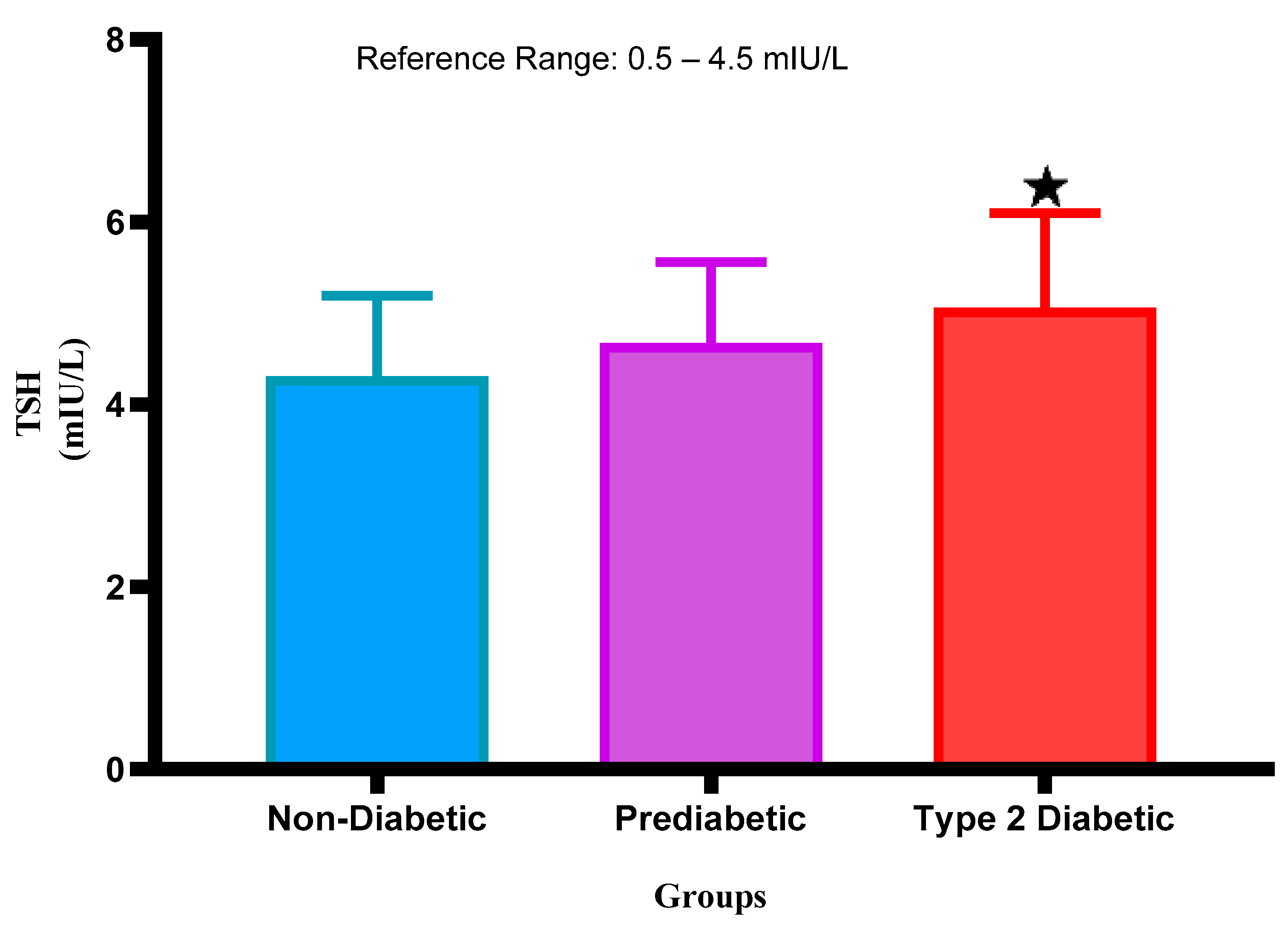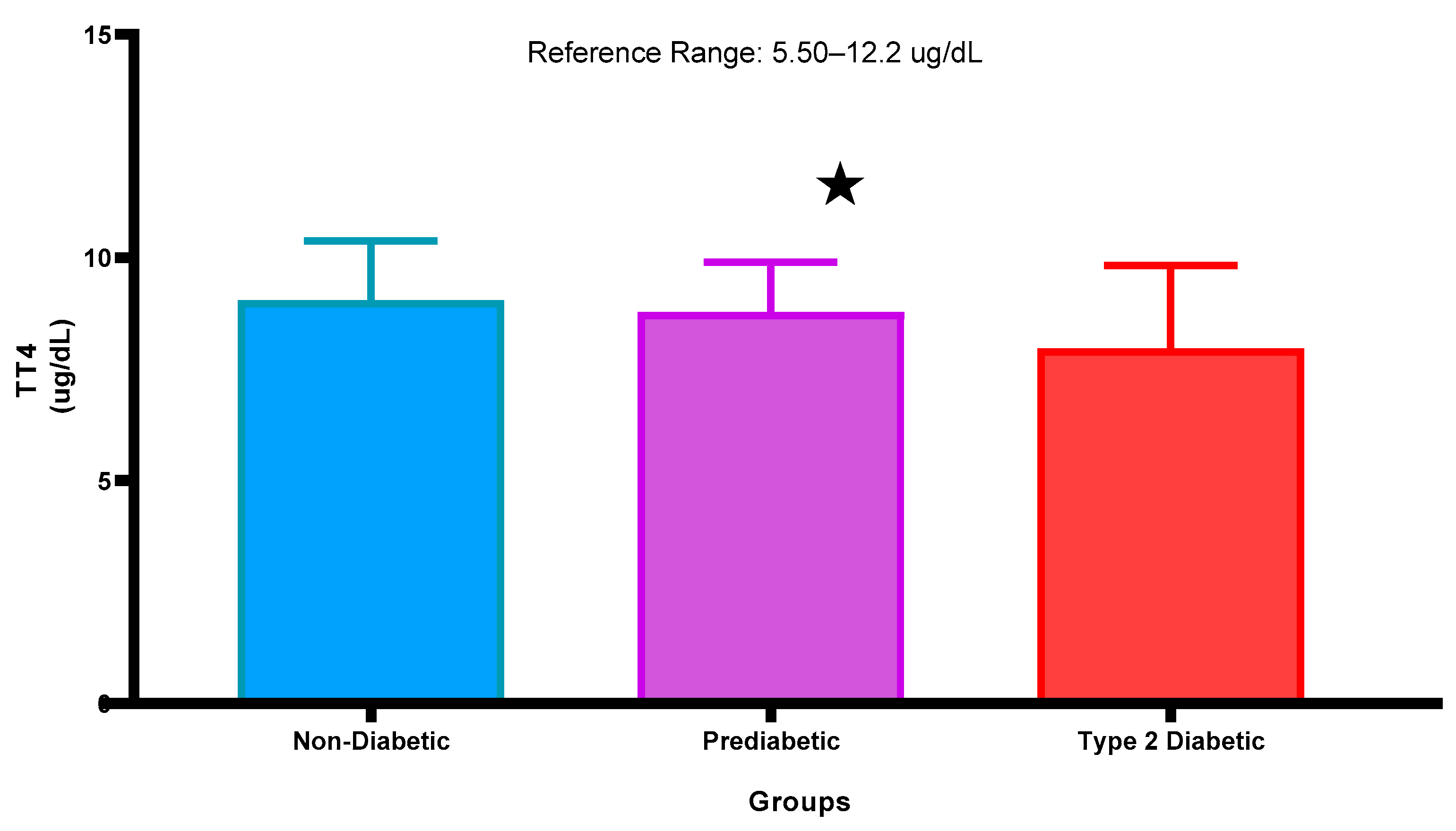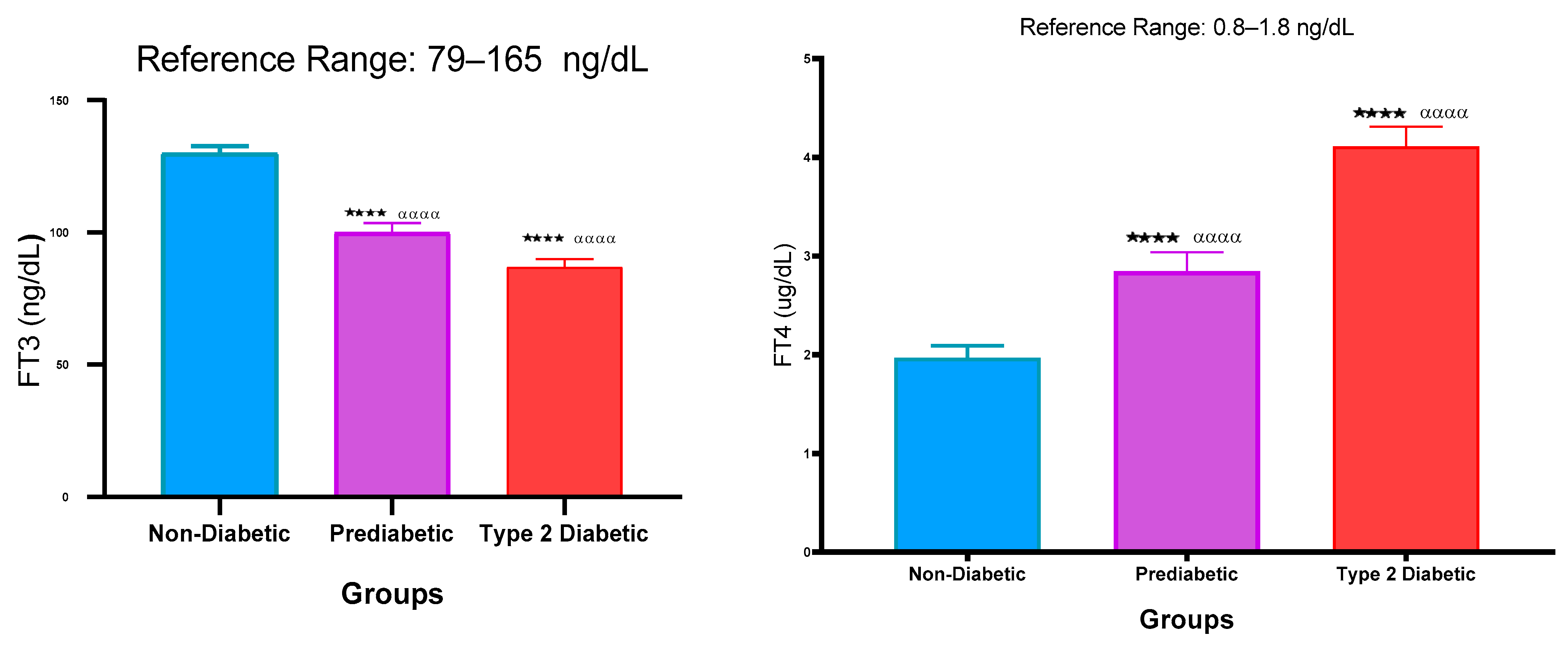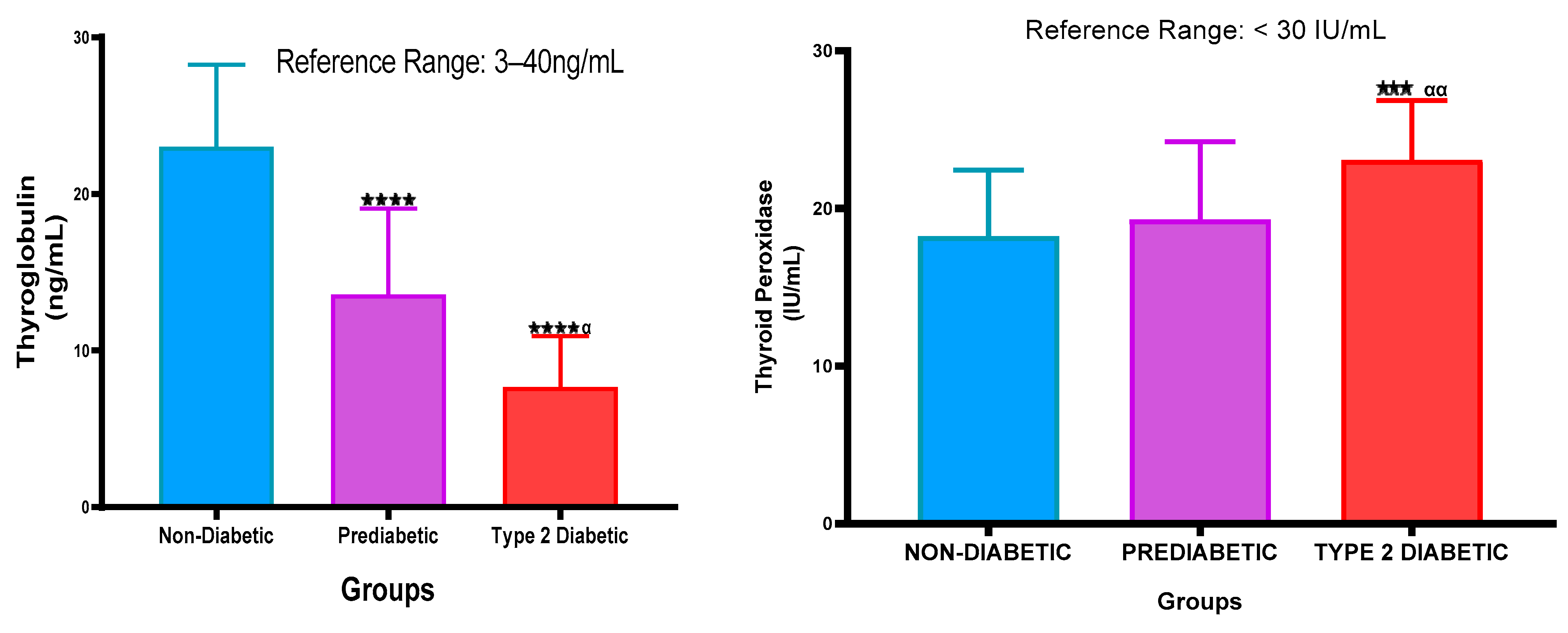A Retrospective Analysis of the Changes in Prediabetes-Associated Markers of Thyroid Function in Patients from Durban, South Africa
Abstract
1. Introduction
2. Results
| Non-Pre-Diabetic | Prediabetic | Type 2 Diabetic | |
|---|---|---|---|
| Age (mean) | 37.69 (34.80–40.58) | 37.70 (35.34–40.06) | 38.48 (36.12–40.85) |
| Sex | |||
| Male | 7 | 21 | 16 |
| Female | 20 | 7 | 12 |
| Fasting Glucose median (IQR) | 4.9 mmol/L (4.6–5.5) | 6.4 mmol/L (6.0–6.9) | 8.5 mmol/L (7.6–9.75) |
| HbA1c mean (95% CI) | 5.24% (5.135–5.35) | 6.08% (5.985–6.178) | 10.78% (9.506–12.05) |
2.1. Thyroid Stimulating Hormone (TSH) Concentration

2.2. Total Triiodothyronine (T3) Concentration

2.3. Total Thyroxine Concentrations

2.4. Free Triiodothyronine (FT3) and Free Thyroxine (FT4) Concentration

2.5. Thyroglobulin (TG) and Thyroid Peroxidase Antibody Concentration

| Group | Biomarker | ||||
|---|---|---|---|---|---|
| Thyroid Stimulating Hormone | Triiodothyronine | Thyroxine | Thyroglobulin | Thyroid Peroxidase Antibody | |
| PD | −0.09 | −0.30 | −0.14 | 0.09 | 0.05 |
| T2DM | 0.27 | −0.40 | 0.17 | 0.23 | −0.24 |
| Group | Biomarker | ||||
|---|---|---|---|---|---|
| Thyroid Stimulating Hormone | Triiodothyronine | Thyroxine | Thyroglobulin | Thyroid Peroxidase Antibody | |
| PD | −0.30 | 0.20 | 0.12 | 0.60 | −0.10 |
| T2DM | 0.25 | -0.50 | 0.47 | 0.14 | −0.20 |
3. Discussion
4. Methods and Materials
4.1. Study Design and Setting
4.2. Prediabetes Diagnosis and Eligibility Criteria
4.3. Sample Processing
4.4. Biochemical Analysis
4.5. Statistical Analysis
5. Conclusions
6. Limitations and Future Studies
Author Contributions
Funding
Institutional Review Board Statement
Informed Consent Statement
Data Availability Statement
Acknowledgments
Conflicts of Interest
Abbreviations
| TSH | Thyroid Stimulating Hormone |
| T4 | Thyroxine |
| T3 | Triiodothyronine |
| TG | Thyroglobulin |
| TPOAb | Thyroid Peroxidase Antibody |
| TPO | Thyroid Peroxidase |
| UKZN | University of KwaZulu Natal |
| BREC | Biomedical Research Ethics Committee |
| ADA | American Diabetes Association |
| NPD | Non-Prediabetic |
| PD | Prediabetic |
| T2DM | Type 2 Diabetes Melittus |
| HbA1c | Glycated Haemoglobin |
| IFG | Impaired Fasting Glucose |
| OGTT | Oral Glucose Tolerance Test |
| BMI | Body Mass Index |
| IGT | Impaired Glucose Tolerance |
| SD | Standard Deviation |
| IQR | Interquartile Range |
| CI | Confidence Interval |
Appendix A
| Hormone (Units) | NPD | PD | T2DM |
|---|---|---|---|
| Thyroid Stimulating Hormone (mIU/L) | |||
| Male | 4.362 (3.801–4.924) | 4.592 (3.204–5.980) | 5.253 (4.348–6.159) |
| Female | 4.23 (3.75–4.708) | 4.700 (4.323–5.077) | 4.916 (4.320–5.513) |
| Triiodothyronine (nmol/L) | |||
| Male | 1.483 (1.358–1.608) | 1.551 (1.350–1.752) | 1.552 (1.442–1.662) |
| Female | 1.579 (1.443–1.1715) | 1.379 (1.249–1.509) | 1.450 (1.334–1.567) |
| Thyroxine (ug/dL) | |||
| Male | 9.417 (7.882–10.95) | 8.299 (6.982–9.615) | 8.098 (6.840–9.356) |
| Female | 8.792 (8.072–9.513) | 8.914 (8.367–9.461) | 7.861 (6.615–9.107) |
| Thyroglobulin (ng/mL) | |||
| Male | 21.84 (16.09–27.59) | 13.86 (7.733–19.99) | 7.907 (4.563–11.25) |
| Female | 23.75 (21.21–26.29) | 13.49 (10.78–16.20) | 7.548 (5.839–9.257) |
| Thyroid Peroxidase Antibody (IU/mL) | |||
| Male | 17.02 (14.46–19.57) | 18.73 (14.03–23.42) | 22.97 (20.11–25.83) |
| Female | 18.60 (16.22–20.98) | 19.53 (16.96–22.11) | 23.16 (20.99–25.33) |
References
- Ha, J.; Lee, J.; Lim, D.-J.; Lee, J.-M.; Chang, S.-A.; Kang, M.-I.; Kim, M.-H. Association of serum free thyroxine and glucose homeostasis: Korea National Health and Nutrition Examination Survey. Korean J. Intern. Med. 2021, 36, S170. [Google Scholar] [CrossRef] [PubMed]
- McAninch, E.A.; Bianco, A.C. Thyroid hormone signaling in energy homeostasis and energy metabolism. Ann. N. Y. Acad. Sci. 2014, 1311, 77–87. [Google Scholar] [CrossRef]
- Martinez, B.; Ortiz, R.M. Thyroid hormone regulation and insulin resistance: Insights from animals naturally adapted to fasting. Physiology 2017, 32, 141–151. [Google Scholar] [CrossRef]
- Eom, Y.S.; Wilson, J.R.; Bernet, V.J. Links between thyroid disorders and glucose homeostasis. Diabetes Metab. J. 2022, 46, 239. [Google Scholar] [CrossRef]
- ELSheref, S.E.M.; El-Samee, A.; Samir, H.; Abdulrehim, M.M.; Berengy, M.S. Thyroid Function in Euthyroid subjects and Its Association with Insulin Resistance. Int. J. Med. Arts 2022, 4, 1986–1992. [Google Scholar] [CrossRef]
- Makandar, A.; Sonagra, A.D.; Shafi, N. Study of thyroid function in type 2 diabetic and non-diabetic population. Int. J. Med. Sci. Public Health 2015, 4, 769–772. [Google Scholar] [CrossRef]
- Khassawneh, A.H.; Al-Mistarehi, A.-H.; Zein Alaabdin, A.M.; Khasawneh, L.; AlQuran, T.M.; Kheirallah, K.A.; Saadeh, N.A.; Beni Yonis, O.; Shawkat, M.; Obeidat, N. Prevalence and predictors of thyroid dysfunction among type 2 diabetic patients: A case–control study. Int. J. Gen. Med. 2020, 13, 803–816. [Google Scholar] [CrossRef]
- Ahmed, R. Thyroid-insulin dysfunction during development. Int. J. Res. Stud. Zool. 2017, 3, 73–75. [Google Scholar]
- Kalra, S.; Aggarwal, S.; Khandelwal, D. Thyroid dysfunction and type 2 diabetes mellitus: Screening strategies and implications for management. Diabetes Ther. 2019, 10, 2035–2044. [Google Scholar] [CrossRef] [PubMed]
- Grigoriadis, G.; Koufakis, T.; Kotsa, K. Epidemiological, Pathophysiological, and Clinical Considerations on the Interplay between Thyroid Disorders and Type 2 Diabetes Mellitus. Medicina 2023, 59, 2013. [Google Scholar] [CrossRef]
- Jun, J.E.; Jee, J.H.; Bae, J.C.; Jin, S.-M.; Hur, K.Y.; Lee, M.-K.; Kim, T.H.; Kim, S.W.; Kim, J.H. Association between changes in thyroid hormones and incident type 2 diabetes: A seven-year longitudinal study. Thyroid 2017, 27, 29–38. [Google Scholar] [CrossRef] [PubMed]
- Liu, B.; Wang, Z.; Fu, J.; Guan, H.; Lyu, Z.; Wang, W. Sensitivity to thyroid hormones and risk of prediabetes: A cross-sectional study. Front. Endocrinol. 2021, 12, 657114. [Google Scholar] [CrossRef]
- Zhang, Y.; Lu, P.; Zhang, L.; Xiao, X. Association between lipids profile and thyroid parameters in euthyroid diabetic subjects: A cross-sectional study. BMC Endocr. Disord. 2015, 15, 12. [Google Scholar] [CrossRef] [PubMed][Green Version]
- Huang, X.; Zhang, X.; Zhou, X.; Han, X.; Fu, Z.; Li, Y.; Ji, L. Prevalence of thyroid dysfunction in a chinese population with different glucose intolerance status: A community-based cross-sectional study. Diabetes Metab. Syndr. Obes. 2020, 13, 4361–4368. [Google Scholar] [CrossRef]
- Gholampour Dehaki, M.; Amouzegar, A.; Delshad, H.; Mehrabi, Y.; Tohidi, M.; Azizi, F. Thyroid dysfunction in patients with impaired glucose metabolism: 11 year follow up from the Tehran thyroid study. PLoS ONE 2017, 12, e0184808. [Google Scholar] [CrossRef]
- Irari, A. Prevalence of Sub-Clinical Hypothyroidsim and Its Correlation with Diabetic Nephropathy in Patients with Type 2 Diabetes Mellitus at Kenyatta National Hospital. Mater’s Dissertation, University of Nairobi, Nairobi, Kenya, 2020. [Google Scholar]
- Lambadiari, V.; Mitrou, P.; Maratou, E.; Raptis, A.E.; Tountas, N.; Raptis, S.A.; Dimitriadis, G. Thyroid hormones are positively associated with insulin resistance early in the development of type 2 diabetes. Endocrine 2011, 39, 28–32. [Google Scholar] [CrossRef]
- Mzimela, N.C.; Sosibo, A.M.; Ngubane, P.S.; Khathi, A. The changes that occur in the immune system during immune activation in pre-diabetic patients of all ethnicities, from the age of 25- to 45-years: A systematic review and meta-analysis. Medicine 2022, 101, e30903. [Google Scholar] [CrossRef] [PubMed]
- Fermín-Martínez, C.A.; Paz-Cabrera, C.D.; Basile-Alvarez, M.R.; Castro, P.S.; Núñez-Luna, A.; Perezalonso-Espinosa, J.; Ramírez-García, D.; Antonio-Villa, N.E.; Vargas-Vázquez, A.; Fernández-Chirino, L. Prevalence of prediabetes in Mexico: A retrospective analysis of nationally representative surveys spanning 2016–2022. Lancet Reg. Health—Am. 2023, 28, 100640. [Google Scholar] [CrossRef]
- Gidey, G.; Hiruy, M.; Teklu, D.; Ramanathan, K.; Amare, H. Prevalence of Prediabetes and Related Modifiable Cardiovascular Risk Factors Among Employees of Ayder Comprehensive Specialized Hospital, Tigray, Northern Ethiopia. Diabetes Metab. Syndr. Obes. 2023, 16, 643–652. [Google Scholar] [CrossRef]
- Ogurtsova, K.; da Rocha Fernandes, J.; Huang, Y.; Linnenkamp, U.; Guariguata, L.; Cho, N.H.; Cavan, D.; Shaw, J.; Makaroff, L. IDF Diabetes Atlas: Global estimates for the prevalence of diabetes for 2015 and 2040. Diabetes Res. Clin. Pract. 2017, 128, 40–50. [Google Scholar] [CrossRef] [PubMed]
- Gassasse, Z.; Smith, D.; Finer, S.; Gallo, V. Association between urbanisation and type 2 diabetes: An ecological study. BMJ Glob. Health 2017, 2, e000473. [Google Scholar] [CrossRef]
- Sosibo, A.M.; Mzimela, N.C.; Ngubane, P.S.; Khathi, A. Prevalence and correlates of pre-diabetes in adults of mixed ethnicities in the South African population: A systematic review and meta-analysis. PLoS ONE 2022, 17, e0278347. [Google Scholar] [CrossRef] [PubMed]
- Alkahtani, S.A. Association Between Diabetic Dyslipidemia and Thyroid Dysfunction in Najran Region of Saudi Arabia: A Retrospective Cross-Sectional Study. Curr. Top. Nutraceutical Res. 2022, 20, 610. [Google Scholar] [CrossRef]
- Sosibo, A.M.; Mzimela, N.C.; Ngubane, P.S.; Khathi, A. Prevalence of pre-diabetes in adults aged 25–45 years in a Durban-based clinical setting, South Africa: A retrospective study. Prim. Care Diabetes 2023, 17, 650–654. [Google Scholar] [CrossRef] [PubMed]
- Pillay, M.; Mosili, P.; Akinnuga, A.; Sibiya, N.; Ngubane, P.; Khathi, A. Association between Altered Thyroid Function and Prediabetes in Diet-Induced Prediabetic Male Sprague Dawley Rats. Diabetology 2023, 4, 406–417. [Google Scholar] [CrossRef]
- Cicatiello, A.G.; Di Girolamo, D.; Dentice, M. Metabolic effects of the intracellular regulation of thyroid hormone: Old players, new concepts. Front. Endocrinol. 2018, 9, 474. [Google Scholar] [CrossRef]
- Mullur, R.; Liu, Y.-Y.; Brent, G.A. Thyroid hormone regulation of metabolism. Physiol. Rev. 2014, 94, 355–382. [Google Scholar] [CrossRef]
- Reddy, M.; Seshadri, S. A Study of Thyroid Dysfunction in Type 2 Diabetes Mellitus in Tertiary Care Center. Int. J. Contemp. Med. Res. 2020, 7, A22–A26. [Google Scholar]
- Rong, F.; Dai, H.; Wu, Y.; Li, J.; Liu, G.; Chen, H.; Zhang, X. Association between thyroid dysfunction and type 2 diabetes: A meta-analysis of prospective observational studies. BMC Med. 2021, 19, 257. [Google Scholar] [CrossRef] [PubMed]
- Biondi, B.; Kahaly, G.J.; Robertson, R.P. Thyroid dysfunction and diabetes mellitus: Two closely associated disorders. Endocr. Rev. 2019, 40, 789–824. [Google Scholar] [CrossRef]
- DeFronzo, R.A.; Ferrannini, E.; Groop, L.; Henry, R.R.; Herman, W.H.; Holst, J.J.; Hu, F.B.; Kahn, C.R.; Raz, I.; Shulman, G.I. Type 2 diabetes mellitus. Nat. Rev. Dis. Primers 2015, 1, 15019. [Google Scholar] [CrossRef]
- Sosibo, A.M.; Mzimela, N.C.; Ngubane, P.S.; Khathi, A. Hormone imbalances detected in study participants with pre-diabetes in a Durban-based clinical setting, South Africa. Int. J. Diabetes Dev. Ctries. 2024, 44, 1–8. [Google Scholar] [CrossRef]
- American Diabetes Association Professional Practice Committee. 2. Classification and diagnosis of diabetes: Standards of Medical Care in Diabetes—2022. Diabetes Care 2022, 45, S17–S38. [Google Scholar] [CrossRef] [PubMed]
- Mzimela, N.C.; Sosibo, A.M.; Ngubane, P.S.; Khathi, A. Investigation into changes in inflammatory and immune cell markers in pre-diabetic patients from Durban, South Africa. J. Immunotoxicol. 2024, 21, 2290282. [Google Scholar] [CrossRef]
- Gul, K.; Ozdemir, D.; Dirikoc, A.; Oguz, A.; Tuzun, D.; Baser, H.; Ersoy, R.; Cakir, B. Are endogenously lower serum thyroid hormones new predictors for thyroid malignancy in addition to higher serum thyrotropin? Endocrine 2010, 37, 253–260. [Google Scholar] [CrossRef] [PubMed]
- Hoermann, R.; Eckl, W.; Hoermann, C.; Larisch, R. Complex relationship between free thyroxine and TSH in the regulation of thyroid function. Eur. J. Endocrinol. 2010, 162, 1123–1129. [Google Scholar] [CrossRef]
- Kang, Y.M.; Koo, B.S.; Yi, H.-S.; Kim, J.T.; Park, B.; Lee, J.H.; Shong, M.; Kang, Y.E. Association between DIO2 Thr92Ala polymorphism and hypertension in patients with hypothyroidism: Korean Genome and Epidemiology Study. Korean J. Intern. Med. 2023, 38, 226. [Google Scholar] [CrossRef] [PubMed]
- Yang, W.; Jin, C.; Wang, H.; Lai, Y.; Li, J.; Shan, Z. Subclinical hypothyroidism increases insulin resistance in normoglycemic people. Front. Endocrinol. 2023, 14, 1106968. [Google Scholar] [CrossRef] [PubMed]
- Thapa, S.; Tamrakar, R. Thyroid screening in prediabeties: Does it have any role? In Proceedings of the International Congress of Diabetes and Metabolism, Seoul, Republic of Korea, 10–12 October 2019; p. 100. [Google Scholar]
- Arvan, P.; Di Jeso, B. Thyroglobulin structure, function, and biosynthesis. In The Thyroid: Fundamental and Clinical Text, 9th ed.; Braverman, L.E., Utiger, R.D., Eds.; Lippincott Williams and Wilkins: Philadelphia, PA, USA, 2005; p. 77. [Google Scholar]
- Coscia, F.; Taler-Verčič, A.; Chang, V.T.; Sinn, L.; O’Reilly, F.J.; Izoré, T.; Renko, M.; Berger, I.; Rappsilber, J.; Turk, D. The structure of human thyroglobulin. Nature 2020, 578, 627–630. [Google Scholar] [CrossRef]
- Carvalho, D.P.; Dupuy, C. Thyroid hormone biosynthesis and release. Mol. Cell. Endocrinol. 2017, 458, 6–15. [Google Scholar] [CrossRef]
- Citterio, C.E.; Targovnik, H.M.; Arvan, P. The role of thyroglobulin in thyroid hormonogenesis. Nat. Rev. Endocrinol. 2019, 15, 323–338. [Google Scholar] [CrossRef]
- Korbozova, N.K.; Kudrina, N.O.; Zhukova, N.A.; Grazhdannikov, A.E.; Blavachinskaya, I.V.; Seitimova, G.A.; Kulmanov, T.E.; Tolstikova, T.G.; Terletskaya, N.V. Antihypothyroid Effect of Salidroside. Molecules 2022, 27, 7487. [Google Scholar] [CrossRef] [PubMed]
- Mendez, D.A.; Ortiz, R.M. Thyroid hormones and the potential for regulating glucose metabolism in cardiomyocytes during insulin resistance and T2DM. Physiol. Rep. 2021, 9, e14858. [Google Scholar] [CrossRef] [PubMed]
- Dimitriadis, G.; Mitrou, P.; Lambadiari, V.; Boutati, E.; Maratou, E.; Panagiotakos, D.B.; Koukkou, E.; Tzanela, M.; Thalassinos, N.; Raptis, S.A. Insulin Action in Adipose Tissue and Muscle in Hypothyroidism. J. Clin. Endocrinol. Metab. 2006, 91, 4930–4937. [Google Scholar] [CrossRef] [PubMed]
- Kochman, J.; Jakubczyk, K.; Bargiel, P.; Janda-Milczarek, K. The influence of oxidative stress on thyroid diseases. Antioxidants 2021, 10, 1442. [Google Scholar] [CrossRef]
- Macvanin, M.T.; Gluvic, Z.; Zafirovic, S.; Gao, X.; Essack, M.; Isenovic, E.R. The protective role of nutritional antioxidants against oxidative stress in thyroid disorders. Front. Endocrinol. 2023, 13, 1092837. [Google Scholar] [CrossRef]
- Yuan, C.; Sun, X.; Liu, Y.; Wu, J. The thyroid hormone levels and glucose and lipid metabolism in children with type 1 diabetes: A correlation analysis. Transl. Pediatr. 2021, 10, 276. [Google Scholar] [CrossRef]
- Huang, K.; Liang, Y.; Ma, Y.; Wu, J.; Luo, H.; Yi, B. The variation and correlation of serum adiponectin, nesfatin-1, IL-6, and TNF-α levels in prediabetes. Front. Endocrinol. 2022, 13, 774272. [Google Scholar] [CrossRef]
- Abdulbaki, Z.H.; Mohammed, H.A. Relationship of Thyroid Stimulating Hormone with Coronary Artery Disease in Patients Undergoing Diagnostic Coronary Angiography. Rafidain J. Sci. 2013, 24, 108–119. [Google Scholar] [CrossRef]
- Schroeder, A.C.; Privalsky, M.L. Thyroid hormones, t3 and t4, in the brain. Front. Endocrinol. 2014, 5, 40. [Google Scholar] [CrossRef]
- Al-Suhaimi, E.A.; Khan, F.A. Thyroid glands: Physiology and structure. In Emerging Concepts in Endocrine Structure and Functions; Springer: Singapore, 2022; pp. 133–160. [Google Scholar]
- Damiano, F.; Rochira, A.; Gnoni, A.; Siculella, L. Action of thyroid hormones, T3 and T2, on hepatic fatty acids: Differences in metabolic effects and molecular mechanisms. Int. J. Mol. Sci. 2017, 18, 744. [Google Scholar] [CrossRef]
- Chidakel, A.; Mentuccia, D.; Celi, F. Peripheral metabolism of thyroid hormone and glucose homeostasis. Thyroid 2005, 15, 899–903. [Google Scholar] [CrossRef] [PubMed]
- Teixeira, S.d.S.; Panveloski-Costa, A.C.; Carvalho, A.; Monteiro Schiavon, F.P.; Ruiz Marque, A.d.C.; Campello, R.S.; Bazotte, R.B.; Nunes, M.T. Thyroid hormone treatment decreases hepatic glucose production and renal reabsorption of glucose in alloxan-induced diabetic Wistar rats. Physiol. Rep. 2016, 4, e12961. [Google Scholar] [CrossRef]
- Jiffri, E. Relationship between lipid profile blood and thyroid hormones in patient with type 2 diabetes mellitus. Adv. Obes. Weight Manag. Control. 2017, 6, 178–182. [Google Scholar] [CrossRef]
- Palma, C.C.S.S.V.; Pavesi, M.; Nogueira, V.G.; Clemente, E.L.S.; Vasconcellos, M.d.F.B.M.P.; Pereira, L.C.; Pacheco, F.F.; Braga, T.G.; Bello, L.d.F.; Soares, J.O.; et al. Prevalence of thyroid dysfunction in patients with diabetes mellitus. Diabetol. Metab. Syndr. 2013, 5, 58. [Google Scholar] [CrossRef]
- Verma, S.; Singhal, V.; Gupta, H.; Khan, I.; Anil Kumar, K.; Dara, N. Prevalence of Thyroid Disorders in Patients with Type 2 Diabetes Mellitus. J. Diabetes Endocr. Pract. 2020, 03, 75–78. [Google Scholar] [CrossRef]
- Köhrle, J. Thyroid hormone transporters in health and disease: Advances in thyroid hormone deiodination. Best Pract. Res. Clin. Endocrinol. Metab. 2007, 21, 173–191. [Google Scholar] [CrossRef]
- Teixeira, P.d.F.d.S.; Dos Santos, P.B.; Pazos-Moura, C.C. The role of thyroid hormone in metabolism and metabolic syndrome. Ther. Adv. Endocrinol. Metab. 2020, 11, 2042018820917869. [Google Scholar] [CrossRef]
- Mehran, L.; Amouzegar, A.; Abdi, H.; Delbari, N.; Madreseh, E.; Tohidi, M.; Mansournia, M.A.; Azizi, F. Incidence of thyroid dysfunction facing metabolic syndrome: A prospective comparative study with 9 years of follow-up. Eur. Thyroid J. 2021, 10, 390–398. [Google Scholar] [CrossRef] [PubMed]
- Liu, Z.-m.; Li, G.; Wu, Y.; Zhang, D.; Zhang, S.; Hao, Y.-T.; Chen, W.; Huang, Q.; Li, S.; Xie, Y. Increased Central and Peripheral Thyroid Resistance Indices During the First Half of Gestation Were Associated With Lowered Risk of Gestational Diabetes—Analyses Based on Huizhou Birth Cohort in South China. Front. Endocrinol. 2022, 13, 806256. [Google Scholar] [CrossRef]
- Su, J.; Ding, X.; Xu, Y.; Liu, R.; Gu, M.; Chen, Y.; Yin, Y.; Wang, Y.; Sun, H.; Peng, Y. Different levels of thyroid hormones between impaired fasting glucose and impaired glucose tolerance: Free T3 affects the prevalence of impaired fasting glucose and impaired glucose tolerance in opposite ways. Clin. Endocrinol. 2014, 80, 890–898. [Google Scholar]
- Gu, L.; Yang, J.; Gong, Y.; Ma, Y.; Yan, S.; Huang, Y.; Wang, Y.; Peng, Y. Lower free thyroid hormone levels are associated with high blood glucose and insulin resistance; these normalize with metabolic improvement of type 2 diabetes. J. Diabetes 2021, 13, 318–329. [Google Scholar] [CrossRef] [PubMed]
- Oda, T.; Taneichi, H.; Takahashi, K.; Togashi, H.; Hangai, M.; Nakagawa, R.; Ono, M.; Matsui, M.; Sasai, T.; Nagasawa, K. Positive association of free triiodothyronine with pancreatic β-cell function in people with prediabetes. Diabet. Med. 2015, 32, 213–219. [Google Scholar] [CrossRef] [PubMed]
- Mulla, I.G.; Anjankar, A.; Pratinidhi, S.A.; Lambe, S.D.; Agrawal, S.V. Oxidative Stress in Prediabetic Young Adults. Cureus 2024, 16, e62504. [Google Scholar] [CrossRef] [PubMed]
- Maschirow, L.; Khalaf, K.; Al-Aubaidy, H.; Jelinek, H. Inflammation, coagulation, endothelial dysfunction and oxidative stress in prediabetes—Biomarkers as a possible tool for early disease detection for rural screening. Clin. Biochem. 2015, 48, 581–585. [Google Scholar] [CrossRef]
- Lang, X.; Li, Y.; Zhang, D.; Zhang, Y.; Wu, N.; Zhang, Y. FT3/FT4 ratio is correlated with all-cause mortality, cardiovascular mortality, and cardiovascular disease risk: NHANES 2007–2012. Front. Endocrinol. 2022, 13, 964822. [Google Scholar] [CrossRef] [PubMed]
- Santos-Palacios, S.; Brugos-Larumbe, A.; Guillén-Grima, F.; Galofré, J.C. A cross-sectional study of the association between circulating TSH level and lipid profile in a large Spanish population. Clin. Endocrinol. 2013, 79, 874–881. [Google Scholar] [CrossRef]
- Mondal, S.; Raja, K.; Schweizer, U.; Mugesh, G. Chemistry and Biology in the Biosynthesis and Action of Thyroid Hormones. Angew. Chem. Int. Ed. 2016, 55, 7606–7630. [Google Scholar] [CrossRef]
- McLachlan, S.M.; Rapoport, B. Thyroid peroxidase as an autoantigen. Thyroid 2007, 17, 939–948. [Google Scholar] [CrossRef] [PubMed]
- Hu, Y.; Zheng, J.; Ye, X.; Song, Y.; Wu, X. Association between elevated thyroid peroxidase antibody and abdominal fat distribution in patients with type 2 diabetes mellitus. Diabetes Metab. Syndr. Obes. Targets Ther. 2022, 15, 863–871. [Google Scholar] [CrossRef]
- Sarfo-Kantanka, O.; Sarfo, F.S.; Ansah, E.O.; Yorke, E.; Akpalu, J.; Nkum, B.C.; Eghan, B. Frequency and determinants of thyroid autoimmunity in Ghanaian type 2 diabetes patients: A case-control study. BMC Endocr. Disord. 2017, 17, 1–8. [Google Scholar] [CrossRef] [PubMed]
- Anan, N.M. Association Between Thyroid Dysfunction and Type II Diabetes Mellitus Among Adults in Benghazi City. Bachelor’s Dissertation, Libyan International Medical University, Benghazi, Libya, September 2019. [Google Scholar]
- Duntas, L.H.; Orgiazzi, J.; Brabant, G. The interface between thyroid and diabetes mellitus. Clin. Endocrinol. 2011, 75, 1–9. [Google Scholar] [CrossRef] [PubMed]
Disclaimer/Publisher’s Note: The statements, opinions and data contained in all publications are solely those of the individual author(s) and contributor(s) and not of MDPI and/or the editor(s). MDPI and/or the editor(s) disclaim responsibility for any injury to people or property resulting from any ideas, methods, instructions or products referred to in the content. |
© 2025 by the authors. Licensee MDPI, Basel, Switzerland. This article is an open access article distributed under the terms and conditions of the Creative Commons Attribution (CC BY) license (https://creativecommons.org/licenses/by/4.0/).
Share and Cite
Aswani, H.S.; Mdluli, W.; Khathi, A. A Retrospective Analysis of the Changes in Prediabetes-Associated Markers of Thyroid Function in Patients from Durban, South Africa. Int. J. Mol. Sci. 2025, 26, 2170. https://doi.org/10.3390/ijms26052170
Aswani HS, Mdluli W, Khathi A. A Retrospective Analysis of the Changes in Prediabetes-Associated Markers of Thyroid Function in Patients from Durban, South Africa. International Journal of Molecular Sciences. 2025; 26(5):2170. https://doi.org/10.3390/ijms26052170
Chicago/Turabian StyleAswani, Hasnaa Satar, Wendy Mdluli, and Andile Khathi. 2025. "A Retrospective Analysis of the Changes in Prediabetes-Associated Markers of Thyroid Function in Patients from Durban, South Africa" International Journal of Molecular Sciences 26, no. 5: 2170. https://doi.org/10.3390/ijms26052170
APA StyleAswani, H. S., Mdluli, W., & Khathi, A. (2025). A Retrospective Analysis of the Changes in Prediabetes-Associated Markers of Thyroid Function in Patients from Durban, South Africa. International Journal of Molecular Sciences, 26(5), 2170. https://doi.org/10.3390/ijms26052170






